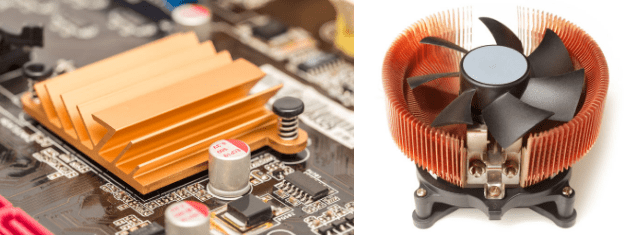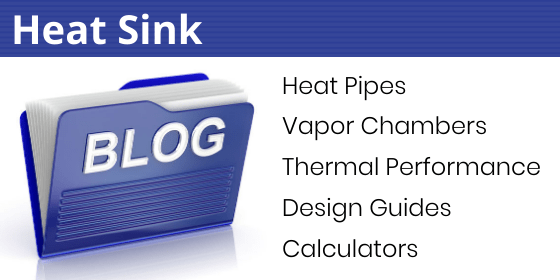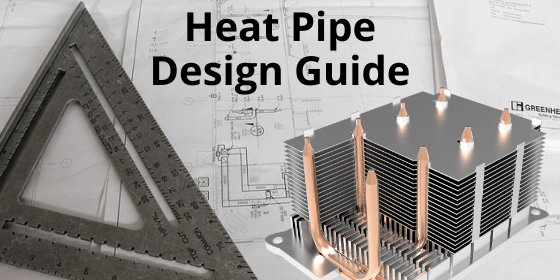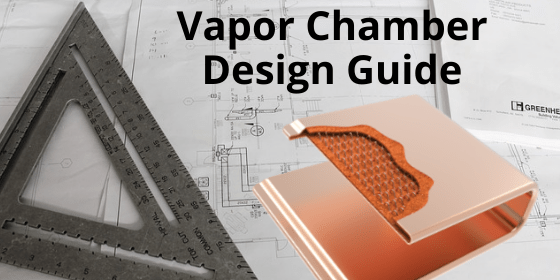Heat Sink Types
In order to choose the correct heat sink for cooling electronic applications, it’s useful for engineers to understand the definitions, uses and benefits of different types of heat sinks. Here are some guidelines for the types of heat sinks that are commonly used in conjunction with heat pipes and vapor chambers. They vary by air flow, material, use of water and manufacturing process.
Heat Sinks Categorized by Airflow
Passive Heat Sink
Passive heat sinks are those that don’t rely on forced air flow (fans) and are considered more reliable than active solutions. A good example is a heat sink that doubles as the device enclosure. In this example, heat is moved from one or more heat generating components to one or more enclosure walls. These walls typically have a fin array exposed to the outside ambient air.

Passive Heat Sink | Active Heat Sink
Active Heat Sink
Heat sink assemblies that have a powered device such as a fan or blower in close proximity to the heat exchanger surface are active heat sinks. These would also include heat sinks that rely on pumped liquid to remove latent heat from the heat source. Because active heat sinks rely on forced air to be passed across the fin area, they are more efficient – which translates to a smaller and lighter heat sink design.
Heat Sinks Categorized by Material
Heat sink material for electronics cooling applications is almost always aluminum or copper.
Aluminum Heat Sink
Aluminum is lightweight easy to manufacture and cost effective, making it an ideal choice for most heat sinks. Alloys 6061 and 6063 are the most common alloys while 1050 and 1100 is purer with slightly higher conductivity. Its ability to move heat, thermal conductivity, is about half of copper. This limits the distance heat can be moved, conducted, away from the heat source in the base of a heat sink.
Copper Heat Sink
With a thermal conductivity of around 400 W/m-K, copper is used when heat sinks need a performance boost. Typical alloys for copper plate is CDA110 (391 w/mK). The drawback is copper is 3 times heavier and twice the cost of its aluminum counterpart. It is also slightly slower to work than aluminum. Some types of heat sinks, such as bonded fin, can be made of both materials: one for the base and the other for the fins.
Heat Sinks Categorized by Use of Water
As clumsy as this category might sound, it really just includes solid metal heat sinks assemblies, heat sinks using two-phase devices, and pumped liquid heat sinks.
Solid Metal Heat Sink
Solid metal heat sinks consist of a base into which heat is absorbed and a fin array from which heat is dissipated into the surrounding air. Depending on the heat sink manufacturing process, the base and fins can be made from different metals – copper or aluminum for electronics cooling. Typically, these are the least expensive types of heat sinks.
Pumped Liquid Heat Sink
Heat sinks using pumped liquid usually refer to a configuration where the pump and fin array are remote to the heat source. Liquid is pumped into a cold plate that is attached to the heat source. It then returns to the fin array to be cooled. Although very effective for removing heat it is the least reliable method of cooling electronics.

Solid Metal | Pumped | Two-Phase Heat Sinks
Two-Phase Heat Sink
Vapor chambers and heat pipes are the most common two-phase devices and can be incorporated into heat sink assemblies to boost performance. The overall performance of the heat sink assembly is improved because of the very high thermal conductivity of these two-phase devices. Typically, heat pipes will move heat from the heat source to a remote fin array while vapor chambers are used to spread heat across the base of a local fin array. These types of heat sinks are nearly as reliable as solid metal ones while costing slightly more. Celsia specialized in this type of heat sink.
Heat Sinks by Manufacturing Process
The most common manufacturing methods for heat sinks used in conjunction with heat pipes or vapor chambers are CNC machined, forged, die cast, zipper fin, extruded, bonded, and skived.

Types of Heat Sinks by Manufacturing Process
CNC Machined Heat Sink
Complex design options as well as high thermal conductivity are the two main benefits of CNC machined heat sinks. They are somewhat costly to manufacture and have a relatively slow manufacturing throughput rate, eliminating them as an option for inexpensive and/or high-volume products.
Forged & Die Cast Heat Sinks
Like forged heat sinks, die cast heat sinks offer low unit cost for high volume production. However, up front tooling cost is prohibitive for small to medium quantities. Die cast and cold forged heat sinks offer very good thermal performance. Forged heat sinks offer good design flexibility for intricate heat sinks while die cast heat sinks are limited to thicker fins making them ideal for enclosure lids used in natural convection applications.
Zipper Fin Heat Sink
A favorite when paired with heat pipes or vapor chambers, zipper fin heat sinks are low weight and offer the ability for thin, densely packed fins and ease of integration with two-phase devices. Vapor chambers can be used as the base of the fin array while heat pipes can run through the center of the fins to efficiently dissipate heat. Tooling cost and unit price is reasonable.
Skived Fin Heat Sink
Excellent thermal properties, thin fins, a high fin aspect ratio, and low tooling cost are the hallmarks for skived fin heat sinks. However fins can easily become bent.
Bonded Fin Heat Sink
When a very large heat sink is required, bonded fins are likely the answer. Another advantage is the base can be made of a different material than the fins.
Extruded Heat Sink
Extruded heat sinks are incredibly cost-effective yet offer limited design flexibility without secondary operations like CNC machining.
Related Links
Celsia is a custom heat sink manufacturer using vapor chamber and heat pipe technology. We specialize in: heat sink design, heat sink proto, heat sink manufacturing, heat pipes, vapor chambers, custom heat pipe wick materials.










